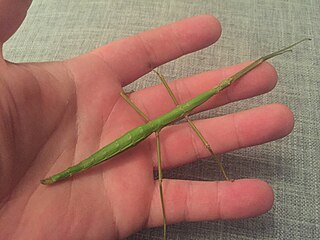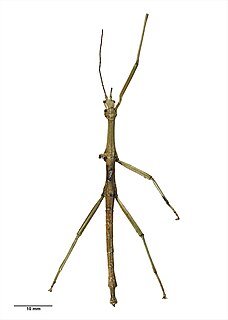 W
WAcanthoxyla is a genus of stick insects in the family Phasmatidae. All the individuals of the species are female and reproduce asexually by parthenogenesis. The genus is the result of interspecific hybridisation resulting in some triploid lineages and some diploid lineages. The genus is endemic to New Zealand, but some species have been accidentally introduced elsewhere. The genus name Acanthoxyla translates from Greek as prickly stick.
 W
WAcanthoxyla inermis is an insect that was described by John Tenison Salmon 1955. Acanthoxyla inermis is included in the genus Acanthoxyla, and family Phasmatidae. No subspecies are listed. This species is native to New Zealand but has been unintentionally moved to Great Britain where it has grown a stable population and is the longest insect observed, and the most common of the stick insects that have established themselves on the island.
 W
WAcanthoxyla prasina, the prickly stick insect, is a stick insect in the order Phasmatodea and the family Phasmatidae. It is found throughout New Zealand, although it is less frequently reported than "common" stick insect species. It has a thorny skin, which is used as camouflage.
 W
WArgosarchus is a monotypic genus in the family Phasmatidae containing the single species Argosarchus horridus, or the New Zealand bristly stick insect, a stick insect endemic to New Zealand. The name "horridus" means bristly in Latin, likely referring to its spiny thorax.
 W
WClitarchus is a genus of stick insects in the Phasmatidae family and Phasmatinae sub-family. This genus is the most common stick insect in New Zealand. It is found widely throughout the North Island and part of the South Island on kanuka and manuka, as well as various common garden plants.
 W
WClitarchus hookeri, is a stick insect of the family Phasmatidae, endemic to New Zealand. It is possibly New Zealand's most common stick insect. Clitarchus hookeri is often green in appearance, but can also be brown or red.
 W
WNiveaphasma annulata is a species of stick insect found in New Zealand.
 W
WPseudoclitarchus sentus is the sole representative of the genus Pseudoclitarchus, and is a stick insect endemic to the Three Kings Islands. It lives mainly on kanuka trees.
 W
WSpinotectarchus acornutus is a species of stick insect endemic to New Zealand. It belongs to the family Diapheromeridae, and is the only member of the genus Spinotectarchus. It is commonly referred to as the spiny ridge-backed stick insect.